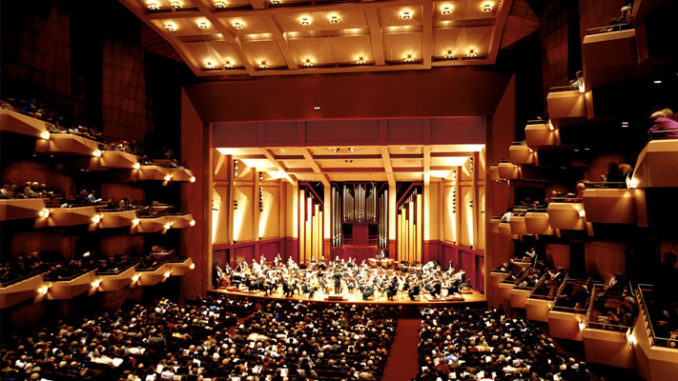
Why all the etiquette? Because the symphony delivers music in a way that no other venue can. Up to one hundred musicians perform on stage and not one of them is plugged into an outlet. For the sound of the instruments to reach the full effect, the acoustics are precise and the audience remains quiet. It truly is the audience and musicians working together to bring the music to life the way the composer meant it to be.
Before You Go
Which symphony to attend?
This is a matter of personal taste. You could opt for the classics, like Mozart or Beethoven, or go for something more current. There is no right or wrong answer here. Check out your local symphony’s website and see what’s offered. Search Google for the music and listen to see if it fits your tastes. People’s musical appetites are unique. Choose what interests YOU. What moves one person, puts another to sleep.
Where to sit?
You chose your symphony, now let’s find a place for you to sit. In the majority of symphony halls, there is no bad seat in the house. The acoustics are so precise you can hear the man in the front row cough even if you’re seated in the back. More on coughing later. However, if you want to see the instruments and musicians’ faces, sit closer to the stage. The box seats are more expensive but offer a good view because they are higher than the stage. The main floor seating is also good, however, the rows are wide. Meaning, if you sit in the middle of center floor, you have to wait for everyone else to exit the row before you can leave for intermission or to go home. Check out the seating charts for your local symphony to help make your choice. Better yet, give the box office a call. Box office staff are very helpful and know their venue well.
Inside tip – Sitting on the aisle in the center or in a box allows for a quick departure, either for the food and beverage lines at intermission or at the end for the parking garage or grabbing a cab. Remember, attending the symphony is about hearing the music much more than seeing the music.
What to wear?
“Whether it’s Birkenstocks or a ball gown, please wear whatever makes you feel comfortable.” – The Seattle Symphony
Inside tip – Never wear perfume. A patron next to you may be allergic.
When to arrive?
How and when to navigate to your seat?
Etiquette tip – How to enter a row of seats? – You should enter the row facing them and say, “Excuse me, thank you,” as you move through to your seat. It’s not polite to show the person your backside as you move through.
Once seated?
Etiquette Tip – The Proper Way to Clap –You’ll be doing a lot of clapping at a symphony and knowing how to properly clap is essential. Always clap with your hands slightly off to your left and clap in small brisk movements. Your left hand should remain static and your right hand does the moving. Never clap in front of your face. Now get your hands ready, because the clapping starts now.
How the symphony starts?
During the Performance
Etiquette Tip – How to read your program during a performance? It’s okay to read your program as the symphony progresses. Try not to turn pages and read it low by your lap, do not raise it up to read it. That is distracting to the people around you.
Insider Tip – People cough or clear their throats between movements when everything is silent. This is normal. When the music starts back up, everyone is silent again.
When to clap?
- Entrance of the Concertmaster (first violin)
- Any soloists
- The Conductor
- End of each piece (not at the end of each movement)
- End of the symphony. Clap and clap some more.
- Still unsure? Just clap when everyone else does.
Need to Cough?
Try to cough when the music isn’t playing. If you need to cough during the music and cough drops aren’t working, try to muffle your cough in your clothing. If a coughing fit is inevitable, we’ve all been there, just excuse yourself and the people around you will thank you for it.
Intermission and What’s With the Blinking Lights?
Insider tip – Drape your program on top of your seat like your laying a towel over it when leaving for intermission. This will hold the page you are on and keep the program off the floor.
Intermissions are usually 15 minutes long. This is your chance to go to the bathroom, grab a snack or call the kids at home. A line will form at the ladies room, plan accordingly. The symphony hall lets you know when to return to your seat with flashing lights or an understated fluttering tone. Start assembling yourself at the first flicker and head back to your seat. Depending on the hall, you will receive two or three warnings before the performance starts up again.
The Closing of the Performance and Should You Give a Standing Ovation?
At the end of the symphony you clap. A lot. If you clap vigorously, your arms and hands will ache. This is where you pace yourself. Start slowly and ramp it up from there if appropriate. The conductor usually turns around to face the audience and bows, you clap. He or she will also acknowledge the musicians by turning towards them, you clap. The soloists will be acknowledged, you clap. Keep clapping with the audience. If you are beside yourself with amazement at the performance of the music, stand up and clap louder. You can even yell, “Bravo!” A standing ovation is the best compliment you can give the conductor and musicians. Just keep clapping with everyone else. The musicians will rise in acknowledgement and thank you! Sometimes the conductor will exit the stage, the musicians stay seated and then the conductor comes back out. This isn’t an encore, they’re showing appreciation for the musicians, Concertmaster, Soloists and you. The exit and re-entry can happen up to three times. Keep clapping.
Etiquette Tip – How to clap during a standing ovation? Stand, lift your elbows high and slightly to the left, then clap small and briskly. Remember, no clapping in front of your face.
When is it over?
Generally, a good rule of thumb is the performance is over when the house lights come on. Gather your things together and depart after witnessing one of the most beautiful artful expression of music!
My hope is this guide is helpful to you and your enjoyment of the symphony! Bravo to you!



